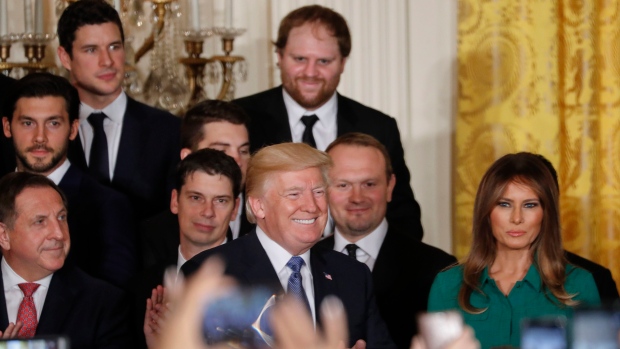Oct 11, 2017
How the Penguins avoided politics in Washington
To suggest the Stanley Cup champions went into Tuesday’s White House visit blindly and willing to be used in whatever way President Trump deemed necessary is incorrect, Dave Naylor writes.
By Dave Naylor

Long before he became President of the United States, Donald Trump made his name as a dealmaker.
And judging by what went on at Tuesday’s White House visit by the Pittsburgh Penguins, it appears there may have been some backroom deal-making that went on in advance.
Since he entered the presidential race, Trump has rarely, if ever, has missed an opportunity to advance his political message to both his supporters and detractors, making every public moment about himself and his positions, and openly attacking his opponents.
That’s what made the Penguins’ decision to accept his invitation to the White House so risky. With the president having recently turned pro sports into a battleground on race, freedom of speech and patriotism, it seemed that the Stanley Cup champions were sure to be turned into political pawns.
Except that didn’t happen.
No mention of the NFL, the anthem protests, or the Golden State Warriors not coming to the White House.
No subtle suggestion that hockey players were in some way morally superior to other athletes, the kind of thing that might have obvious and uncomfortable overtones.
Trump made a NAFTA joke, but a year ago then-president Barack Obama had used the Penguins visit to praise the NHL’s environmental initiatives to highlight climate change.
Beyond that, calling a group of players from six different nations “great patriots” was as political as it got.
So what happened? Why did a president who never does things the traditional way and uses every public forum to advance his own causes, shelve the politics and follow what was essentially the same script as every other president who has hosted a Stanley Cup championship team?
Why was the Penguins’ visit to the White House far less political than when the New England Patriots visited in June, despite the fact that Trump himself had gone out of his way to politicize sports in the weeks leading up to Tuesday?
The Penguins had defended their decision to visit the White House by saying it was non-political, the same way their previous visits to presidents Obama or Bush had been.
But of course they didn’t control what was going to happen when they walked into the White House, standing behind the president and in front of all those cameras.
Or did they?
It is well known that Penguins co-owner Ron Burkle is a Democrat, as is team president David Morehouse, who worked on the campaigns of Bill Clinton, John Kerry and Al Gore.
So if ever there was a team that would object to being used as political pawns, this was it. NHL sources on Tuesday confirmed that message was almost assuredly communicated to the White House well in advance of the visit.
So did the NHL and the Penguins say to the White House something akin to “We won’t embarrass you by refusing to accept your invitation, but we don’t want to be embarrassed by being used for political purposes”?
It sure seems so.
And so while the Penguins insisted they were treating this like any other White House visit, perhaps in some subtle ways they weren’t.
There was also no public presentation of a jersey with the president’s last name written across the back, the way the Patriots had done when they visited in June or the Penguins had done a year earlier with Obama.
And it was noted that Crosby was positioned in the back row to the far left of Trump, which would have put him out of most camera shots.
All subtle manoeuvres that one could reasonably conclude were by design.
Crosby may in fact be apolitical, which doesn’t make him unique in the world of professional hockey.
So it was smart of the Penguins to remove him from centre stage, and a scene that could very well have translated into an endorsement of this president and his policies.
The Penguins will still be criticized for going to the White House by those who argue merely accepting the invitation of this President was a de facto endorsement.
But to suggest that they went into Tuesday’s visit blindly and willing to be used in whatever way President Trump deemed necessary is incorrect.



